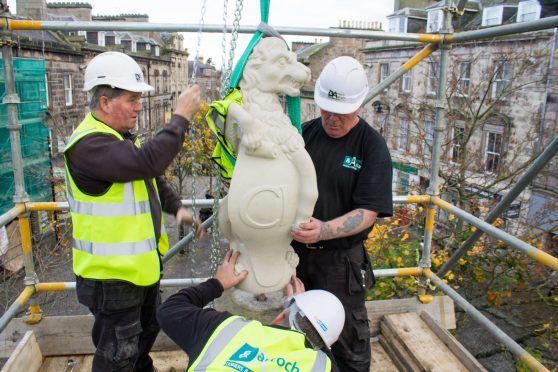One of Elgin’s most recognisable landmarks has roared back to life after the completion of a major restoration project.
A new rampant lion statue is now taking pride of place on top of Muckle Cross, the final part of £45,000 works which have also involved essential repairs and cleaning to stonework.
The original stone beast will now go on display at Elgin Museum.
It comes after the newly-refurbished building was unveiled to the public in April.
Engraved lettering and stone carvings were hidden under decades of soot before the restoration.
The building was shrouded in scaffolding and protective sheets for two months while the work was carried out. Contractors Darroch and Allan used specialist equipment to rub off grime using a fine powder.
Funding for the project to preserve the historic monument came from Moray Council, the Elgin Common Good Fund and the Elgin Conservation Area Regeneration Scheme (CARS).
Councillor Graham Leadbitter, who represents Elgin City South, said: “I am really pleased with the support that the Muckle Cross restoration has received from the councillors.
“The work done on Muckle Cross really complements the rest of the buildings in the area that have taken advantage of the Elgin CARS.
“The Muckle Cross is one of the most significant structures in the city of Elgin and the original lion itself dates back several hundred years.
“When we refurbished the building, the lion was found to be in a poor state of repair. The workers did managed to salvage it and I’m glad that it will now go into the Elgin Museum. It is an important part of the city’s history.”
The Muckle Cross – which stands on the Plainstones in Elgin High Street – was constructed around 1888 although there is believed to have been a cross on the site since the late 1300s.
The original cross was built in the 17th Century before being replaced by the current building in 1880.
Writing etched into the stonework, which can now be read again, reveals a former resident of the town, William MacAndrew, donated the money for the 19th century work.
Town criers used to climb the spiral staircases inside to make proclamations to residents.










